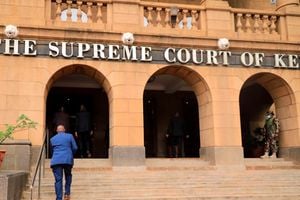
The National Health Insurance Fund (NHIF) building. The NHIF has been replaced by the Social Health Insurance Fund.
Counties are observing the National Health Insurance Fund (NHIF) transition with keen interest. The 47 county governments will carry the greatest responsibility to ensure the success of the reforms since health is largely devolved.
The goal of the change to the Social Health Insurance Fund (SHIF) is noble. The intention is to increase the number of individuals with medical cover for Kenya to realise Universal Health Coverage (UHC).
Under United Nations norms, UHC is achieved when 85 per cent of a country's population has medical cover. At least 27 per cent of individuals in Kenya currently have some form of medical cover. The goal is to push this to about 45 million Kenyans.
And indeed the route towards this has to be increasing resources that we channel to healthcare. A case has been made that current NHIF contributions are "regressive" as, for example, those who are well-off do not make contributions proportionate to their incomes.
Lamu, Kajiado, Kisumu and Muranga have schemes that give free NHIF cards to their vulnerable residents.
The parent law that carries the reforms under SHIF has been passed. What is under consideration in Parliament are regulations which operationalise fully these reforms.
This article highlights areas that ought to be relooked keenly as regulations get debated. But before that, some key points.
NHIF total income is from three sources: Mandatory deductions from the formal sector (about Sh37 billion per annum as at 2022/23); voluntary contributions from informal sector (about Sh3 billion) and enhanced schemes like counties employees schemes or EduAfya (Sh40 billion) totaling about Sh80 billion.
NHIF offers both standard benefits package for those that pay Sh500 per month and enhanced benefits for those who pay more. Standard benefits package includes inpatient/outpatient; emergency evacuation and foreign treatment support of Sh500,000. An enhanced benefits package (also known as super cover) has these plus other benefits. My county of Murang’a has an enhanced package since it has last expense support of Sh100,000 once a beneficiary passes on and includes dental and optical care.
Therefore, the following are areas requiring attention as the country debates the proposed regulations.
First, the enhanced schemes have been abolished. That means the new arrangement will miss out the Sh40 billion that NHIF used to get from these arrangements. Proponents of the reforms argue there is no need for enhanced schemes because the new arrangement will have benefits that mirror to a great extent the enhanced scheme. They cite the emergency, chronic and critical illness Fund, for instance. Parliament must support this fund appropriately and the new card must be acceptable to a wide variety of hospitals otherwise many might resort to private sector schemes.
Second, the logic of the new reforms is to move voluntary contributions from the informal sector from the current annual Sh3 billion to Sh90 billion . That explains the idea of denying government services to those without the new cards, which the courts seems to think is unconstitutional.
The informal sector undertakes "adverse listing "- they only take out NHIF when they sense a medical emergency and drop once that's catered for. That suggests the informal sector is financially constrained.
Contributions from the formal sector will definitely increase but how to squeeze more from the informal sector calls on Parliament to think critically.
Third, the medical sector supply side under the new arrangement needs to be thought through. Once 45 million Kenyans get medical cover, expect an increase in demand for medical services. The experience of Murang’a tells this story: its Level 5 hospital used to get 700 outpatients daily. Today it gets 1,400 after its NHIF programme. This calls for employment of more nurses, doctors, clinical officers and expansion of physical infrastructure. Employment in counties is highly constrained. Wages to development ratio is highly imbalanced. Union activities and employment court decisions tend to exacerbate the problem. Wages consume 45 per cent of the total Murang’a County budget whereas the law caps it at 35 per cent.
Probably the national government needs to devolve more resources to enable counties deal with the expected avalanche of demand for health services.
Fourth, counties need to have a representation in claims management. Presently the regulations place this in the private sector. Counties, by virtue of owning Level 4 hospitals, have a vested interest in fast claims reimbursements.
Finally, what happens to counties medical enhanced schemes? Since the new arrangement will not have extra benefits like optical and dental plus last expense, most likely counties might resort to more expensive private sector medical insurance.
Otherwise the reforms have very good intentions. All ideas need to be incorporated to achieve the noble goals.
- Dr Kangata is the Governor of Murang’a County. Email: [email protected]







